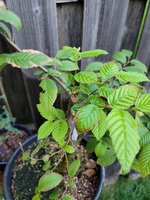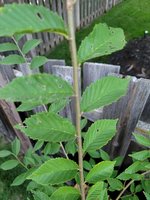@cornfed
I suspect all the leaves imaged are suffering mild to severe nutrient imbalances. Yes, bug bite too for some of them. The Dwarf Chinquapin Oak has the most severe, classic display of nutrient imbalance, reflecting lack of iron. But Redbud & mulberry also looks like low iron.
If your water has a moderate to high total alkalinity, a measure of dissolved calcium carbonate, it is possible that this is making the iron unavailable to the plants. The ones with the most obvious symptoms, the Chinquapin Oak and the Redbud, both prefer acidic soils and are less able to pick up nutrients under alkaline soil conditions. The ones that are pretty green are species known to tolerate calcium carbonates (lime) in their soils. I suspect your problem is related to the total dissolved solids of your irrigation water and the resulting effect on pH. The pH is not the causal factor, it is likely the total dissolved solids of your water. pH is a property governed by total dissolved solids but won't tell you what the dissolved solids are. If you are on a municipal water system get the annual water quality report, it will have the total dissolved solids and other analysis. With the water report you can design a potting media and fertilizer regime that will compensate for your municipal water.
You can make yourself crazy trying to remove calcium from your water. Or you can go crazing adjusting pH. Or you can make nutrients more available by applying fertilizer more frequently (note: not at higher concentration, just more frequently)
You need a fertilizer that supplies both macro nutrients and micro nutrients. Make sure you look at the list of ingredients in any fertilizer you buy. It should be about 20 or so nutrients long, with all the nutrients from the list on your graphic. Apply this fertilizer in dilute quantities, but more frequently. With my orchids I have been known to fertilize every time I water, but at a dilute concentration. You should be fertilizing at least once a week. If you are already using organic fertilizers, the biggest issues with organics it is difficult to supply enough nitrogen and potassium as they tend to flush away rapidly with the first rain.
You could use a more acidic blend of potting media components. For example douglas fir bark chips intended for growing orchids create a nice acidic environment as they decompose. Canadian peat is a good component for acidity, but always sift and discard the peat fines. Only the chunks that don't pass through window screen should be used. Some commercial peat is chopped so fine that only 10 to 20 % stays on the window screen. Peat and bark mixes will break down, they need to be repotted every 2 years. Kanuma has an acidic reaction, you could blend kanuma instead of akadama into your mix.

In the Marketplace section of the Forum, under "Other Selling - bonsai related" I sell a complete fertilizer for acid loving plants, it is my Blueberry Special. There are others who sell acid plant foods. Mira-acid is one. The Blueberry Special I sell is the MSU developed formula for blueberry growers in Michigan. It was designed for irrigation water that is 200 to 600 ppm as Calcium Carbonate. It contains iron, manganese, copper, sulfur and other micro-nutrients in addition to the normal N-P-K, it will help acidify your potting media if used more than once a month. Key is to use it frequently, but in dilute concentration.
























